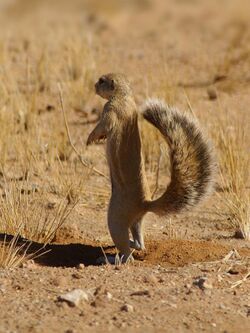African ground squirrel
Topic: Biology
 From HandWiki - Reading time: 2 min
From HandWiki - Reading time: 2 min
| African ground squirrel or xerus Temporal range: Early Pliocene to Recent
| |
|---|---|

| |
| Cape ground squirrel (Xerus inauris) | |
| Scientific classification | |
| Domain: | Eukaryota |
| Kingdom: | Animalia |
| Phylum: | Chordata |
| Class: | Mammalia |
| Order: | Rodentia |
| Family: | Sciuridae |
| Tribe: | Xerini |
| Genus: | Xerus Hemprich & Ehrenberg, 1833 |
| Species | |
|
Xerus erythropus | |
African ground squirrels or xerus[1][2] (genus Xerus) form a taxon of squirrels under the subfamily Xerinae. They are only found in Africa. There is another African ground squirrel of the genus Atlantoxerus, the Atlantoxerus getulus present in southwestern Morocco and northern Western Sahara. It is invasive in the Canary Islands since an introduction in 1971.
There are four species of xerus divided into three subgenera:
- Genus Xerus
- Subgenus Euxerus
- Striped ground squirrel, Xerus erythropus (southwestern Morocco, southern Mauritania and Senegal)
- Subgenus Geosciurus
- Cape ground squirrel, Xerus inauris (also: South African ground squirrel) (Namibia, Botswana, Zimbabwe, South Africa)
- Damara ground squirrel, Xerus princeps (southwestern Angola, Namibia)
- Subgenus Xerus
- Unstriped ground squirrel, Xerus rutilus (northeastern Sudan to northeastern Tanzania)
- Subgenus Euxerus
The squirrels live in open woodlands, grasslands, or rocky country. They are diurnal and terrestrial, living in burrows. Their diet is roots, seeds, fruits, pods, grains, insects, small vertebrates and bird eggs. They live in colonies similar to North American prairie dogs, and have similar behavior. If kept as pets, they run free as house cats do, otherwise farmers consider them pests. Breeding in South African ground squirrels is asynchronous and there is no specific period of breeding although very few litters are seen above the ground in the months of July to October. Gestation period lasts for 48 days and the young ones are weaned after 52 days. There are one to three babies per litter. A female becomes sexually mature when she is 10 months old and a male matures at the age of 8 months. Although a female has the capability to breed throughout the year, less than 10% reproduce more than one litter in a year.
The South African ground squirrel does not hibernate. These squirrels are very social and live in groups with about 1 to 3 females and 2 to 3 males. Sometimes, the number of males can exceed up to 9 with some sub-adult females. An interesting thing about this breed is that mature males like to form their own groups and there can be 19 to 20 individuals in one group. These groups are called bands.
Their home range is shared with other groups which is actually quite a surprising thing, since in case of most of the mammals there is generally an extremely tough competition to get the female. The group-living instinct of this species gives it a survival opportunity from predators overweighing the disadvantage of breeding opportunities which come from competition.
References
- Nowak, Ronald M. 1991. pp. 577–8 Walker's Mammals of the World Fifth Edition, vol. I. Johns Hopkins University Press, Baltimore.
- Thorington, R. W. Jr. and R. S. Hoffman. 2005. Family Sciuridae. pp. 754–818 in Mammal Species of the World a Taxonomic and Geographic Reference. D. E. Wilson and D. M. Reeder eds. Johns Hopkins University Press, Baltimore
Wikidata ☰ Q284816 entry
 KSF
KSF
